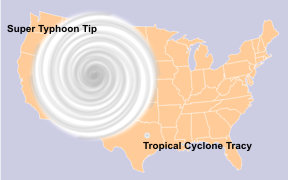Hypercane: Difference between revisions
LaaknorBot (talk | contribs) m robot Adding: sv:Hyperkan |
No edit summary |
||
| Line 1: | Line 1: | ||
A '''hypercane''', or a super-hurricane, is a hypothetical class of extreme [[tropical cyclone]] that could form if ocean temperatures reached around {{convert|50|°C|°F}}, 15 °C higher than the warmest ocean temperature ever recorded<ref>{{cite web |url=http://www.windows.ucar.edu/tour/link=/earth/Water/temp.html&edu=high |title=Temperature of Ocean Water |publisher=[[University Corporation for Atmospheric Research]] |work=Windows to the Universe |date=2001-08-31 |accessdate=2008-07-24}}</ref> |
A '''hypercane''', or a '''super-hurricane''', is a hypothetical class of extreme [[tropical cyclone]] that could form if ocean temperatures reached around {{convert|50|°C|°F}}, 15 °C higher than the warmest ocean temperature ever recorded,<ref>{{cite web |url=http://www.windows.ucar.edu/tour/link=/earth/Water/temp.html&edu=high |title=Temperature of Ocean Water |publisher=[[University Corporation for Atmospheric Research]] |work=Windows to the Universe |date=2001-08-31 |accessdate=2008-07-24}}</ref> which could in turn be caused by a large [[asteroid]] or [[comet]] impact, a large [[volcano|volcanic]] or [[supervolcano|supervolcanic]] eruption, or very extensive [[global warming]].<ref>{{cite web |url=http://ipsnews.net/news.asp?idnews=30308 |title=The Dawn of the Hypercane? |first=Stephen |last=Leahy |publisher=[[Inter Press Service]] |date=2005-09-16 |accessdate=2008-07-24}}</ref> There is some speculation that some [[dinosaur]]s might have been finished off by a series of hypercanes, resulting from an asteroid or comet crashing into [[Earth]].<ref>{{cite journal |title=Did storms land the dinosaurs in hot water? |first=Jeff |last=Hecht |journal=[[New Scientist]] |date=1995-02-04 |url=http://www.newscientist.com/article/mg14519632.600-did-storms-land-the-dinosaurs-in-hot-water.html |issue=1963 |pages=p. 16 |accessdate=2008-07-24 }}</ref> The term was coined by atmospheric scientist [[Kerry Emanuel]] in 1994, at [[MIT]].<ref name="MIT">{{cite web |url=http://wind.mit.edu/~emanuel/holem/holem.html |title=Limits on Hurricane Intensity |first=Kerry |last=Emanuel |publisher=[[Center for Meteorology and Physical Oceanography]], [[MIT]] |date=1996-09-16 |accessdate=2008-07-24 }}</ref><ref>{{cite journal |title=Hypercanes: A Possible Link to Global Extinction Scenarios |first=Kerry |last=Emanuel |coauthors=Kevin Speer, Richard Rotunno, Ramesh Srivastava, Mario Molina |journal= |date=1998-03-22 |volume=100 |issue=D7 |pages=pp. 13755–13765 |journal=[[Journal of Geophysical Research]] |url=http://www.agu.org/pubs/crossref/1995/95JD01368.shtml |accessdate=2008-07-24 }}</ref> |
||
==Physical description== |
==Physical description== |
||
Revision as of 13:53, 4 April 2009
A hypercane, or a super-hurricane, is a hypothetical class of extreme tropical cyclone that could form if ocean temperatures reached around 50 °C (122 °F), 15 °C higher than the warmest ocean temperature ever recorded,[1] which could in turn be caused by a large asteroid or comet impact, a large volcanic or supervolcanic eruption, or very extensive global warming.[2] There is some speculation that some dinosaurs might have been finished off by a series of hypercanes, resulting from an asteroid or comet crashing into Earth.[3] The term was coined by atmospheric scientist Kerry Emanuel in 1994, at MIT.[4][5]
Physical description

Hypercanes would have wind speeds of over 800 kilometres per hour (500 mph) and would also have a central pressure of less than 700 hectopascals (21 inHg), giving them an enormous lifespan.[4] For comparison, the largest and most intense storm on record was 1979's Typhoon Tip, with a wind speed of over 300 kilometres per hour (190 mph) and central pressure of 870 hectopascals (26 inHg).
The extreme conditions needed to create a hypercane could conceivably produce a system up to the size of North America (compare image of Typhoon Tip's size at right), creating storm surges of 18 metres (59 feet) and an eye nearly 300 kilometres (190 mi) across. The waters could remain hot enough for weeks, allowing more hypercanes to be formed. A hypercane's clouds would reach 30 kilometres (19 mi) into the stratosphere. Such an intense storm would also damage the earth's ozone.[4] Water molecules in the stratosphere would react with ozone to accelerate decay into O2 and reduce absorption of ultraviolet light.
Other scientists have theorized that the system, compared to a normal hurricane, would be considerably smaller, about 10 miles in diameter. This would be more comparable to a tornado, which has been recorded at up to about 2.5 miles.[6]
References
- ^ "Temperature of Ocean Water". Windows to the Universe. University Corporation for Atmospheric Research. 2001-08-31. Retrieved 2008-07-24.
- ^ Leahy, Stephen (2005-09-16). "The Dawn of the Hypercane?". Inter Press Service. Retrieved 2008-07-24.
- ^ Hecht, Jeff (1995-02-04). "Did storms land the dinosaurs in hot water?". New Scientist (1963): p. 16. Retrieved 2008-07-24.
{{cite journal}}:|pages=has extra text (help) - ^ a b c Emanuel, Kerry (1996-09-16). "Limits on Hurricane Intensity". Center for Meteorology and Physical Oceanography, MIT. Retrieved 2008-07-24.
- ^ Emanuel, Kerry (1998-03-22). "Hypercanes: A Possible Link to Global Extinction Scenarios". Journal of Geophysical Research. 100 (D7): pp. 13755–13765. Retrieved 2008-07-24.
{{cite journal}}:|pages=has extra text (help); Unknown parameter|coauthors=ignored (|author=suggested) (help) - ^ NOAA Storm Prediction Center (Apr 4, 2006). "The Online Tornado FAQ". Retrieved 2008-09-11.
{{cite web}}: CS1 maint: year (link)
